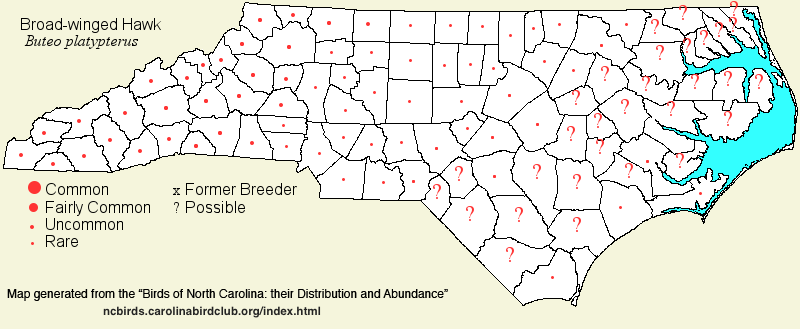 |  |
|
Broad-winged Hawk - Buteo platypterus ACCIPITRIDAE Members: | Search Common: Search Scientific: |
|
|
|||||||
| General Comments | The Broad-winged Hawk is famous for its strongly migratory habits, as it completely leaves the United States in winter, except for small numbers wintering in southern Florida. And, because it has a wide nesting range across southern Canada and the eastern states, large numbers of birds are available to pass through the state in migration, primarily in the fall through the mountains, where it uses northeast-southwest trending ridges for updrafts. A few thousand birds can be seen on certain days, almost always on the first day after a cold front, with strong northwesterly winds helping to provide lift in the form of updrafts against the ridges. It breeds sparingly over most of the state, though more frequently in the western portions. For breeding, it favors extensive, often hilly, deciduous and mixed forests, typically unbroken by fields and pastures. It is difficult to see perched, and thus most birds are detected by its piercing voice or seen circling high overhead, though it forages inside the forest. There have been a handful of winter reports of the species, mostly on CBC's. Nearly all of these lack substantiation and are assumed to have been Red-shouldered Hawks, though several from the Cape Hatteras area were made by experienced birders. | ||||||
| Breeding Status | Breeder | ||||||
| NC BRC List | Definitive | ||||||
| State Status | |||||||
| U.S. Status | |||||||
| State Rank | S4B | ||||||
| Global Rank | G5 | ||||||
| Coastal Plain | Migrant, and very scarce summer resident; declining. Rare to uncommon spring and fall migrant, over most of the region; surprisingly scarce (mostly rare) along the coast, even in fall migration. Very rare in summer (breeder) everywhere, but essentially does not nest along the coast. However, a family group of an adult and two juveniles was seen just north of Oriental (Pamlico) on 28 Jul 2014, strongly suggesting local breeding close to tidal water. Breeding was confirmed in eastern Lenoir in 2023, a very rare recent nesting record for the region. Accidental/casual in winter: 1 immature (photograph), Cape Hatteras, 27 Dec 1984; 1 adult, Buxton, 30 Dec 1987; and 1 adult, central Carteret, 13 Dec 2008. Mainly early or mid-Apr to early Oct, with the spring migration continuing fairly late, into early Jun. Peak counts: 26, over Southern Shores (Dare), 13 Apr 2022; 15, Cedar Island, 8 Jun 1988. | ||||||
| Piedmont | Summer resident and migrant, but declining in recent years. Mostly uncommon migrant (spring and fall); rare to (formerly) very uncommon summer resident (and declining) in the eastern half of the region, and uncommon in the western half, more numerous (uncommon to fairly common) in foothill ranges such as the Brushy Mountains and South Mountains. Noticeable fall migration across the foothills, as noted from hawk-watching stations, such as Pilot Mountain SP. Present mainly from early Apr to early Oct; peak flights in the latter half of Sep. Several winter reports, but these might all relate to Red-shouldered Hawk. Peak counts: 10,835, at Pilot Mountain SP, 22 Sep 1993; 2,718 at that site, 23 Sep 2015; 2,392 at that site, 27 Sep 2014; and 2,271, at that site, 21 Sep 1997. | ||||||
| Mountains | Summer resident and migrant, slightly declining. In summer, uncommon to fairly common, and reasonably widespread, over most of the region, nesting up to about 4,500 feet. Spring migration not overly noticeable, but generally common to at times abundant (a day after a strong cold front) in fall migration, though in a narrow window in the latter half of Sep. Mostly present from mid-Apr to early Oct. One or two winter reports, likely correct: one in Alleghany on a CBC on 30 Dec 2009, and one (same bird?) on the Mount Jefferson CBC on 3 Jan 2010. Peak counts: 9,714 at Grandfather Mountain (Avery), 23 Sep 2015; 4,559 at Grandfather Mountain, 29 Sep 2018; 2,607, in northern Watauga, 28 Sep 2016; 2,279, over Linville Peak (Avery), 20 Sep 2014. | ||||||
| Finding Tips |
If you visit a hawk-watch site in the mountains in fall, such as Pilot Mountain, you might be able to see over 1,000 birds in a day, in the latter half of Sep. Of course, your best bet is a sunny day with northwesterly winds. If you are looking for them in spring or summer, your best bet is the mountains or foothills. You will likely average only one or two birds a day, and you may well only hear one instead of seeing one, as the penetrating whistle can be heard for over a half-mile. *** | ||||||
| Attribution | LeGrand[2023-10-20], LeGrand[2023-03-21], LeGrand[2022-09-14] | ||||||
| NC Map Map depicts all counties with a report (transient or resident) for the species. | Click on county for list of all known species. |
| NC Breeding Season Map Map depicts assumed breeding season abundance for the species. |  |